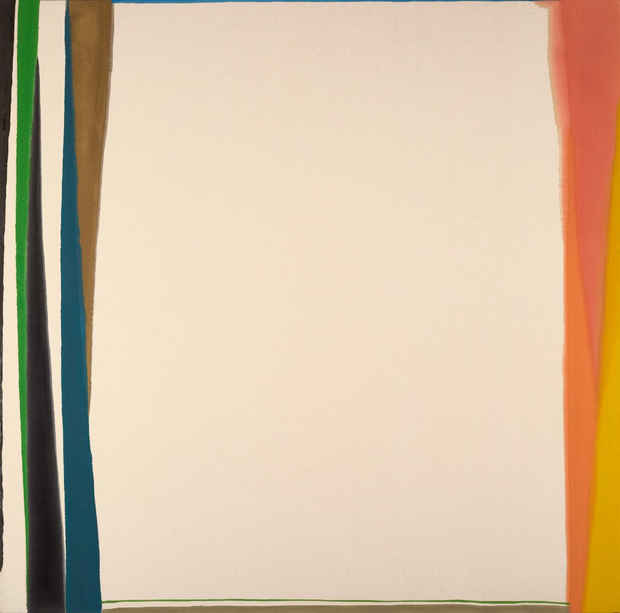Larry Zox “Open Series (1972 - 1975)”
Berry Campbell

[Image: Larry Zox "Untitled" (c. 1973) acrylic on canvas, 65 1/4 x 65 3/4 in.]
This event has ended.
Berry Campbell Gallery presents an important exhibition of paintings by legendary Color Field painter, Larry Zox. The focus of this historic exhibition is his Open Series, painted from 1972 to 1975, with several examples that have not been on public display since his retrospective at the Whitney Museum of Art (1973-1974). This exhibition is accompanied by an eight-page brochure with an essay written by Donald Kuspit, one of America’s most distinguished art historians. The exhibition will open with a reception on Thursday, November 14, 2019 from 6 to 8 pm and continues through December 20, 2019.
With subtle grace and exquisite nuance Larry Zox’s Open Series paintings of 1972 to 1975 create sublime space. They arouse what Roger Fry called “cosmic emotion,” the sense of transcendence implicit in pure abstraction. Each work is an aesthetic masterpiece in its own right, while the series forms majestic choral music. Zox’s Open Series refines—or “quintessentializes”—so-called musical painting. This ideal of abstract painting began with Kandinsky, acknowledging Walter Pater’s view that all art aspires to the condition of music, in which form and content are indistinguishable. Kandinsky’s musical Compositions are Maximalist and expressionist, fraught with turbulent gestures; they tend to sprawl chaotically in euphoric self-indulgence. Zox’s Open Series compositions are Minimalist or Fundamentalist; that is, they distill abstraction to its essence, concentrating it into enigmatic innocence. The vertical gestures—geometrically restrained and calmly in place—are unblemished by expressionistic excitement. They grandly flank central open space that are virginally pure. Where Kandinsky stays on its manic surface, Zox strips musical abstraction to its core. The Open Series paintings burn with a bright, gem-like flame, their deceptive simplicity masking their gravitas.
Larry Zox, Untitled, c. 1973, acrylic on canvas, 93 x 82 inches.
Larry Zox, Untitled, c. 1973, acrylic on canvas, 93 x 82 inches.
Kandinsky called his musical abstractions mood paintings. By such a measure, Zox’s abstractions are mood paintings of somber exhilaration. Zox has been called a color field painter, but his art is not characterized by the disengagement that often denotes such work. What distinguishes the color in his Open Series is its peculiar sobriety, discretion, and intimacy: it draws us into the space of the painting, rather than pushes out at us in a sort of frontal—confrontational—attack, as the color in Gene Davis’s stripe paintings and in Morris Louis’s “unfurled paintings”—to mention two of the artists with whom Zox has been associated. More to the point, Zox’s Open Series has a certain affinity with Robert Motherwell’s Open Series, but Zox’s series is more introspective. Motherwell addresses the theme of the window, in homage to Matisse’s window series. In their series a window separates interior space from exterior space— inside from outside. Zox’s space is all interior, even when it alludes to the exterior. This is the case in works that reference the space of nature, such as Collingsville, 1972, Hudson Canyon, c. 1973, and Hudson Strait, 1973. Nature is a point of departure for Zox; its open space becomes his inner space. For Zox, landscape transforms into what Gerard Manley Hopkins called “inscape.” Slowly and surely, Zox abandoned landscape—he no longer needed it as a stimulus, a source of inspiration. In the two Untitled paintings, Open White, c. 1974, and Untitled, 1975, he made resolutely pure, transcendental abstractions—absolute painting, as it were.
Larry Zox, Albermarle Sound, 1973, acrylic on canvas, 71 x 51 1/2 inches.
Larry Zox, Albermarle Sound, 1973, acrylic on canvas, 71 x 51 1/2 inches.
The Open Series paintings are peculiarly theatrical: one can read the central open space as an empty stage, while the sober-colored geometrical stripes that vertically flank it can seem to function as flattened curtains. This phenomenon is present in the isosceles triangle that marks the right edge of Untitled, 1974, and in the geometrical form on the left in Untitled, 1975, that appear to unfurl or fold.
Resolutely flat, Zox’s Open Series has an important place in the history of planar painting, a term alluding to the Museum of Modern Art’s 1979 exhibition, The Planar Dimension. Accordingly, the grandly elongated stripes—thinner ones mark the top and bottom of the paintings—finesse the edges or frame of the painting, as the noted critic Clement Greenberg said they should in a good modernist work. But testifying to their uncanny character, each is a sort of modified, self-contained expressive gesture. By incompletely measuring the central open space, they it acknowledge its immeasurability. By tentatively limiting it, they suggest its sublime illimitability.
-DONALD KUSPIT-
Media
Schedule
from November 14, 2019 to December 20, 2019